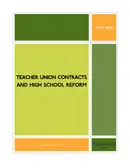Are teachers unions and collective bargaining agreements barriers to high school reform and redesign efforts in Washington, California, and Ohio? The report offers an overview of real and perceived barriers to reform, along with an overview of flexible provisions culled from various collective bargaining agreements.
On one hand, collective bargaining agreements (CBAs) are often perceived as obstacles by many principals and other educators, and to a certain extent this perception becomes reality. On the other hand, CBAs tend to have waiver provisions. And, in perhaps our most significant finding, many of the CBA provisions that we analyzed were more flexible than educators and reform advocates often suggest.
Rather than wade into the pro- versus anti-union debate, this report instead aims to offer guidance for educators, unions, and districts that are interested or engaged in high school reform work. The report offers suggestions and recommendations regarding specific issues raised by interviewees in our previous studies of legal barriers to high school reform and redesign. By highlighting examples of flexible provisions in existing CBAs, the report is designed to be a roadmap for educators and reform advocates looking for more flexibility to implement reform efforts.




